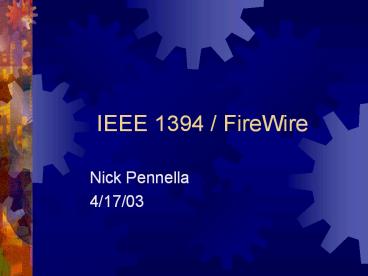IEEE 1394 / FireWire - PowerPoint PPT Presentation
Title:
IEEE 1394 / FireWire
Description:
Isochronous. Broadcast in a one-one one-many fashion. No error correction or re-transmission ... Handles Isochronous transactions. Transaction Layer ... – PowerPoint PPT presentation
Number of Views:1077
Avg rating:3.0/5.0
Title: IEEE 1394 / FireWire
1
IEEE 1394 / FireWire
- Nick Pennella
- 4/17/03
2
Introduction
- -Originally Created by Apple and standardized as
IEEE1394 in 1995 - -Was intended to be used as a desktop LAN
solution for their new generation of Macs - -But when released into the IEEE working group
developed into an interconnect that could
integrate both entertainment and consumer
electronics.
3
Features
- Fast transfer of data
- Lots of devices on the bus
- Ease of use
- Hot pluggable
- Provide power through the cable
- Plug-and-play
- Low cabling cost
- Low implementation cost
4
Performance
5
Standards
- Currently there are three main standards and
hundreds of IEEE recommendations. - For an idea of the enormity of the field check
the IEEE website - http//www.1394ta.org/Technology/Specifications/sp
ecifications.htm - Three standards
- IEEE 1394
- Original Standard, release in 1995
- Supports transfer rates of 100,200,400Mbps
- IEEE 1394a
- Fixed interoperability problems that were left
out of the spec for IEEE 1394 - Added performance enhancements into the spec over
the original - IEEE 1394b
- Enhanced transfer rates for 800 , 1600, 3200Mbps
- Separated the Standard from the Protocol
- Provides long-haul transmission while offering
backward compatability
6
Types of Transfers
- Isochronous
- Broadcast in a one-one one-many fashion
- No error correction or re-transmission
- Uses up-to 80 of the available bandwidth
- Asynchronous
- Targets a specific node at a specific address
- Error Checking and Re-Transmission
- No Guarantee on the amount of bandwidth
7
4 Level Protocol Stack
- Physical Layer
- Used for configuration of the bus
- Electrical Signaling
- Mechanical Connectors / Cabling
- Arbitration Mechanism
- Serial Encoding / Decoding
- Link Layer
- Checking and Appending CRCs
- Determines the type of transaction
- Handles Isochronous transactions
- Transaction Layer
- Handles Asynchronous transactions
(request/response) - Serial Bus Management Layer
- Removed from the 1394b standard
8
Topology
- IEEE 1394 is a peer to peer protocol, meaning a
specific host is not needed for communication - Configuration of the bus occurs when ever a new
device is plugged in - Uses a 64bit address scheme based on the IEEE
1212 standard - 64 bits decomposed as follows
- 10 bits for the Bus ID Allowing 1024 busses
- 6 bits for the Device ID Allowing 64 Devices
- 48 bits for storage
9
Configuration Step 1
10
Configuration Step 2
2 Signals Involved Parent Notify Child
Notify
11
Configuration Step 3
12
Cable (1394-1995 and 1394a)
13
Connector (1394a)
14
Cable Types and Length(1394b)
15
References
- http//www.apple.com
- http//www.embedded.com/1999/9906/
- http//www.1394ta.org/
- http//computer.howstuffworks.com/firewire1.htm































